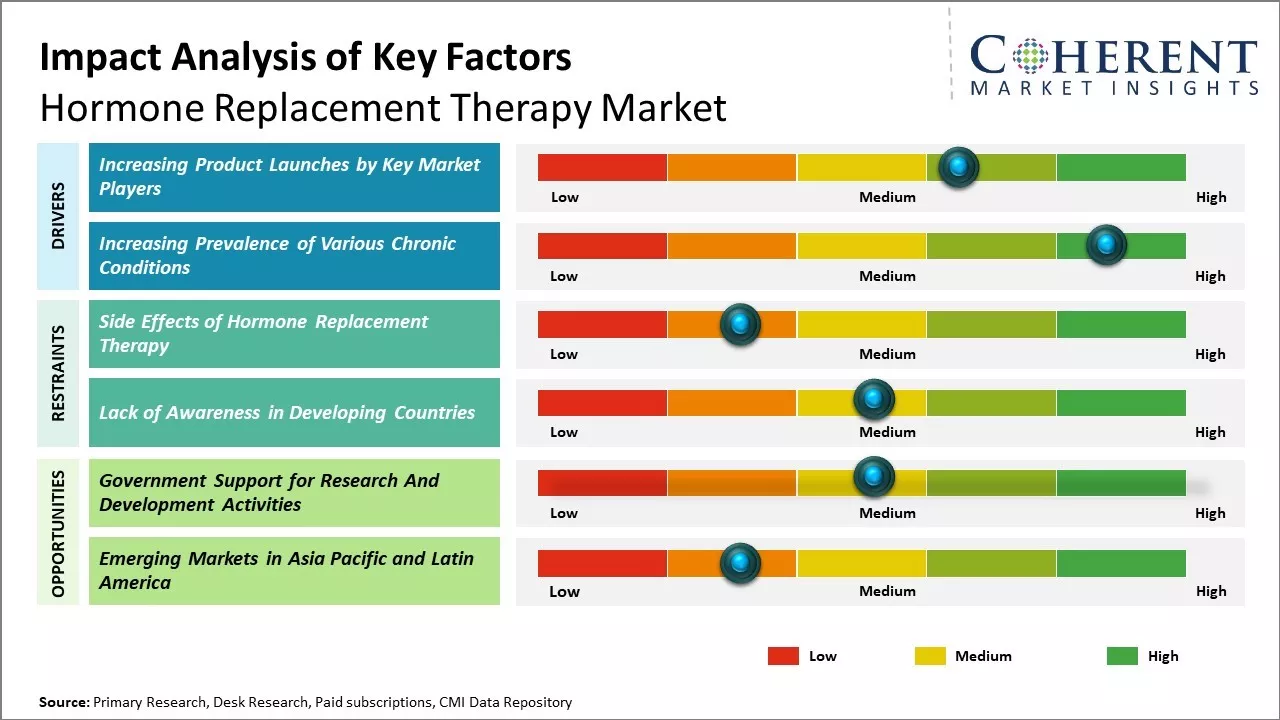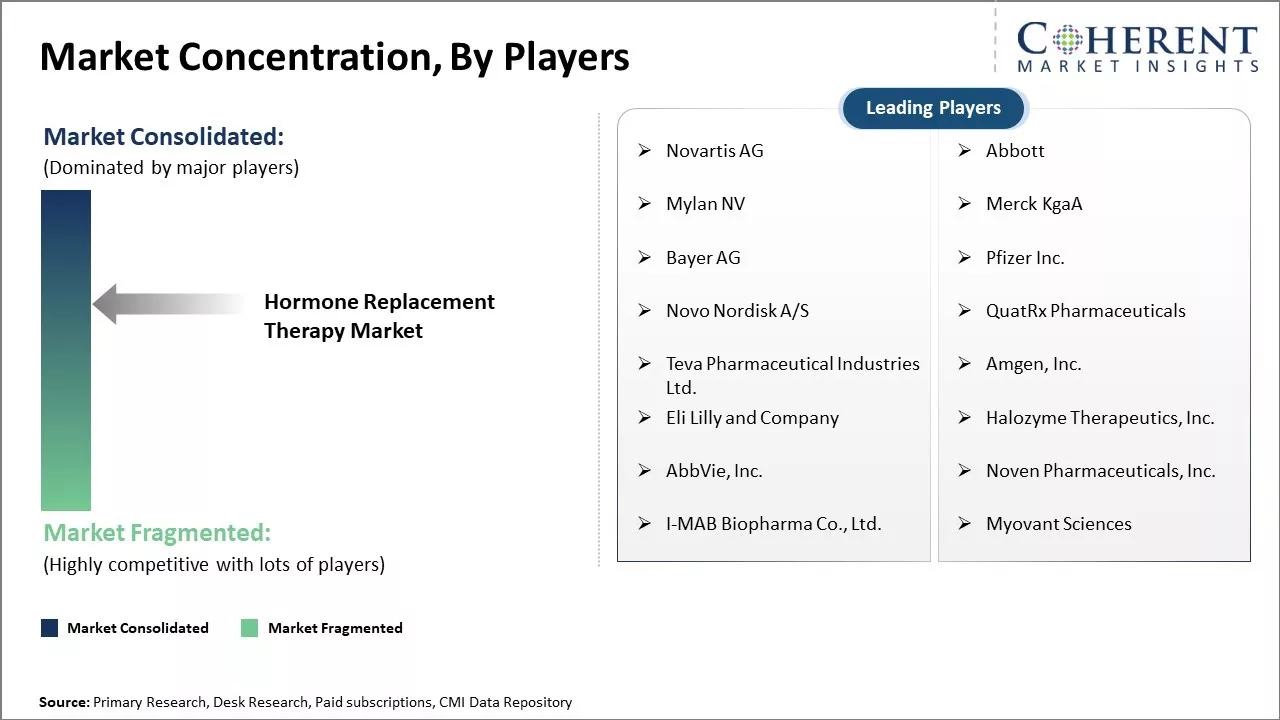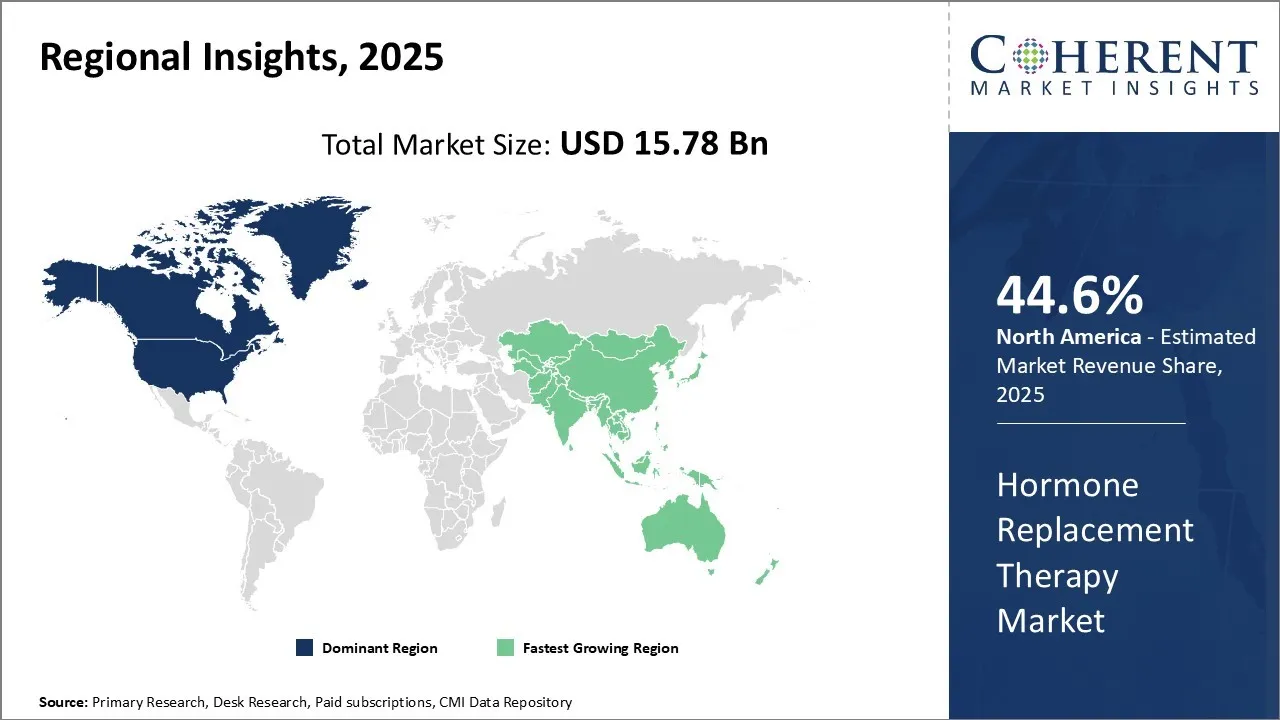The hormone replacement therapy market is estimated to be valued at USD 15.78 Bn in 2025 and is expected to reach USD 23.75 Bn by 2032, exhibiting a compound annual growth rate (CAGR) of 6.0% from 2025 to 2032.

To learn more about this report, Download Free Sample
Rising prevalence of hormonal deficiencies due to the increasing geriatric population is expected to drive the demand for hormone replacement therapy. Additionally, increasing consumer awareness about benefits of the treatment in managing menopausal symptoms is further expected to propel the market growth.
However, risks and side effects associated with the long-term use of hormone replacement therapy such as blood clots, heart attacks, and breast cancer could hamper the market growth.

To learn more about this report, Download Free Sample
|
Current Events |
Description and its impact |
|
Global Drug Shortages and Supply Chain Disruptions |
|
|
Geopolitical and Economic Policy Shifts |
|
Uncover macros and micros vetted on 75+ parameters: Get instant access to report
The increasing prevalence of menopause and its associated symptoms is a significant driver for the expansion of the hormone replacement therapy market. Menopause, a natural biological process marking the end of a woman's reproductive years, often brings a range of symptoms such as hot flashes, night sweats, mood swings, and osteoporosis risk.
For instance, according to a report by the World Health Organization, published in 2024, in 2021, women aged 50 and over accounted for 26% of all women and girls globally. This was up from 22% 10 years earlier. Additionally, women are living longer. Globally, a woman aged 60 years in 2019 could expect to live on average another 21 years.
The human growth hormone (HGH) replacement therapy sub-segment is estimated to hold 36.1% of the market share in 2025, owing to increasing product launch.
The therapy type segment includes estrogen replacement therapy, human growth hormone (HGH) replacement therapy, thyroid replacement therapy, testosterone replacement therapy, and others.
The route of administration segment includes oral, parenteral, and others. The oral sub-segment is estimated to hold 32.9% of the market share in 2025 owing to convenience advantages.
The hormone replacement therapy landscape has seen a persistent shift away from parenteral routes towards oral medications. Various formulations in development focus on oral drug delivery to tap into these perceived benefits driving its popularity. The dominance of the oral administration segment therefore stems primarily from heightened convenience and discretion it provides patients.
The end user segment includes hospital pharmacies, retail pharmacies, and online pharmacies. The hospital pharmacies sub-segment is estimated to hold 43.6% of the market share in 2025, owing to their specialized expertise.
Hormone replacement usually demands oversight from experienced endocrinologists involved in complex diagnoses and treatment planning. Hospitals are better equipped than other channels to handle the multifaceted requirements of HRT. They employ trained staff across departments to efficiently manage the entire treatment cycle from consultation and testing to dispensing therapies and monitoring patient response.
As HRT addresses complex hormonal imbalances often requiring personalized approaches, AI’s integration brings promising advancements in diagnosis, treatment optimization, and patient management.

To learn more about this report, Download Free Sample
North America remains the dominant region in the global hormone replacement therapy market and is estimated to hold 44.6% of the market share in 2025. With the U.S. being home to some of the leading pharmaceutical companies, the regional market has robust infrastructure and supply chain for consistent production and distribution.
Asia Pacific is emerging as the fastest growing regional market for hormone replacement therapy. Countries like China, India, Japan and South Korea have large geriatric populations prone to hormonal decline. With improving access and affordability of healthcare in Asia Pacific, more women are opting for hormone therapy to alleviate menopausal symptoms.
For instance, according to the MedPaltrip, cosmetic surgeries and dental care cost 60-80% less in Malaysia than in the U.S. Fertility treatments and orthopedic surgeries are also very affordable. Malaysia’s private hospitals are accredited by international healthcare organizations, ensuring high standards of quality and safety.
The U.S. stands as the largest market for HRT, driven by a significant aging population, with over 56 million individuals aged 65 and older. The prevalence of menopausal disorders and hypogonadism among the aging demographic fuels the demand for HRT. Transdermal and injectable hormone therapies are especially popular, with over 60% of users opting for estrogen-based therapies.
Germany's well-organized healthcare system and preventive approach to women's health contribute to the growing demand for HRT. The country's aging population, coupled with increased awareness of menopausal symptoms, drives the adoption of HRT as a preferred option. Technological integration, including advanced HRT technologies like transdermal patches and gels, improves patient outcomes. The country's healthcare expenditure supports the procurement of advanced HRT products, further boosting market growth.
In India, increasing awareness about menopause and the availability of healthcare services contribute to the growing demand for HRT. The rising middle class and emphasis on wellness and aging gracefully drive women to seek effective solutions, with HRT being one of the preferred options. The healthcare network is undergoing changes, with more hospitals and clinics offering HRT services, indicating a more comfortable approach to treatment.
In May 2024, Jagsonpal Pharmaceuticals launched MemUp. This is marketed as India’s first hormone replacement therapy combining bioidentical estradiol and progesterone in a single capsule. The formulation holds approval from the U.S. FDA.
China's growing demand for HRT is attributed to an increasing number of women entering menopause and seeking ways to manage their symptoms. The concept of preventive medicine is gaining strength, and with knowledge of the advantages of HRT, adoption is rising among women. Improvements in the healthcare system and government interventions through extended coverage in insurance programs make such therapies more accessible.
Global pharmaceutical giants such as Pfizer, Bayer, Novo Nordisk, and AbbVie are at the forefront of driving product innovation, securing regulatory approvals, and shaping distribution strategies within China’s expanding hormone replacement therapy (HRT) market.
| Report Coverage | Details | ||
|---|---|---|---|
| Base Year: | 2024 | Market Size in 2025: | USD 15.78 Bn |
| Historical Data for: | 2020 To 2024 | Forecast Period: | 2025 To 2032 |
| Forecast Period 2025 to 2032 CAGR: | 6.0% | 2032 Value Projection: | USD 23.75 Bn |
| Geographies covered: |
|
||
| Segments covered: |
|
||
| Companies covered: |
Lonza, Novartis International AG, BASF AG, SEQENS, Carbogen Amcis AG, Eli Lilly and Company, Teva Pharmaceutical Industries Ltd, Bristol-Myers Squibb, Pfizer Inc., Roche Diagnostics, Boehringer Ingelheim, Merck & Co, Bayer AG, Ajinomoto Bio-Pharma Services, Cambrex Corporation, Minakem, and Sanofi Aventis |
||
| Growth Drivers: |
|
||
| Restraints & Challenges: |
|
||
Uncover macros and micros vetted on 75+ parameters: Get instant access to report
*Definition: Hormone replacement therapy is used when human body is not able to produce enough hormones. It is used for the treatment for menopause, hypothyroidism, male hypogonadism, and growth hormone deficiency conditions. The signs that the individual requires hormone replacement therapy are hot flashes, night sweats, vaginal dryness, pain, itching, or burning during intercourse, bone loss, low sex-drive, mood changes, and irritability.
Share
Share
About Author
Vipul Patil is a dynamic management consultant with 6 years of dedicated experience in the pharmaceutical industry. Known for his analytical acumen and strategic insight, Vipul has successfully partnered with pharmaceutical companies to enhance operational efficiency, cross broader expansion, and navigate the complexities of distribution in markets with high revenue potential.
Missing comfort of reading report in your local language? Find your preferred language :
Transform your Strategy with Exclusive Trending Reports :
Frequently Asked Questions
Joining thousands of companies around the world committed to making the Excellent Business Solutions.
View All Our Clients